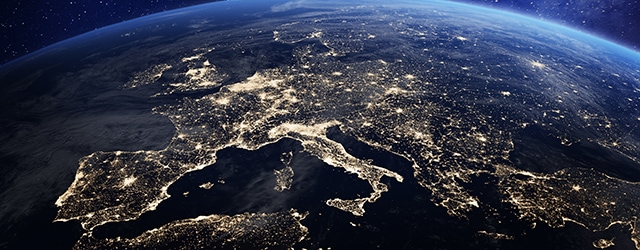Europe has a rich cultural heritage and helped to create the modern world, through industrialization and trade. But many are pessimistic about its future. Can the continent prosper in the 2020s?

The European Union (EU) has had a tough decade, struggling with the aftereffects of the financial crisis and its own euro crisis. Eurozone GDP growth reached a post-2008 crisis high in 2014, pushing GDP back almost to precrisis levels in 2018; but the region’s recovery has been slower than that of Asia or the US, and growth is uneven.
Furthermore, after years of quantitative easing (QE), the ability of the European Central Bank (ECB) to sustain growth is in doubt. The single-currency regime prevents troubled countries from devaluation as a policy tool. There is also soul searching about the EU’s corporate power: Europe has failed to produce a homegrown rival to Google or Alibaba. Many of the region’s biggest companies are seen as laggards in embracing technology. Some argue the bloc’s political structure makes it impossible to fix its problems.
Conventional wisdom is that these economic, political and corporate challenges—combined with an aging population—add up to grim prospects for the EU experiment. Indeed, many observers have suggested that Europe could face one or more lost decades, much like Japan.
But while the EU certainly has difficulties, it would be wrong to write off the region. “Over the past 30 years, Europe has overcome the end of the Cold War, German reunification and the incorporation of CEE countries into the EU,” notes Oksana Antonenko, director at consultancy Control Risks in London. “It has also weathered a deep financial crisis and the eurozone crisis, coming up with a solution that ultimately prompted a recovery even in Southern Europe.” Europe is resilient. A 2020s renaissance is possible.
Economics: Is The ECB Toolkit Empty?
As noted, a decade after the financial crisis, Europe’s economy has recovered reasonably well. Inflation, the central banks’ primary bogeyman, has not returned. “Consequently, we are still in an era of ultralow rates and quantitative easing,” notes Neil Williams, senior economic adviser at Hermes Investment Management in London.
 Fechner, ING: Fiscal stimulus of €1 trillion in the next decade would do much to kickstart growth. |
The ECB has embarked on another round of QE—albeit at a quarter of the rate of five years ago. Furthermore, under its new head, Christine Lagarde, the bank looks set to maintain a -0.5% deposit rate (banks have to pay the ECB to deposit money), making it hard to cut rates further in a downturn. The US Federal Reserve, for comparison, was able to halt QE in 2014. US rates are 1.55%—higher than during the crisis, but still historically low. “The ECB’s conventional monetary toolbox is empty,” Williams says.
Inga Fechner, an economist at ING in Frankfurt, suggests the ECB could be more creative in its stimulus purchases. “It could buy more corporate bonds—to date it has bought only 25% of its possible investment universe—buy bank bonds, or go down the Japanese route and buy equities,” she says.
Further QE carries risks, however. “The big question is whether a new bout of QE will save Europe from becoming more like Japan or hasten that outcome,” Williams says. “The ECB may be so fearful of throwing out the baby of growth with the bathwater of QE that it continues with a policy that undermines the normal mechanisms that lead to economic recovery.”
The solution could be to increase government spending—fiscal stimulus. The trouble is that the EU has no unified fiscal policy to facilitate transfers within the union. This—along with the policy limitations of a single currency—is among the eurozone’s greatest structural weaknesses.
Politics: Diversity Or Division?
“One of the sources of Europe’s success is the variety of countries within the union,” Antonenko says, yet she also acknowledges that same diversity can be an impediment to crafting responses to big issues. “[EU] decision-making is based on consensus, which may not be the right model for unpopular but necessary decisions.”
As Europe’s divisions have sharpened—between northern and southern members and between populist and “conventional” politicians—consensus has become more difficult. France’s President Emmanuel Macron has urged greater centralization in relation to fiscal policy and burden sharing, in order to push structural reform and reenergize economic growth. Top-down reforms are unlikely, however, because institutional restructuring requires a new treaty, which is unlikely to be approved by member states.
Meanwhile, support from Germany for Macron’s reform drive (the Franco-German relationship often determines the EU’s agenda) is predicated on changes in France, which have stalled; and Germany faces a transition of power since Angela Merkel announced she will stand down. “Until the transition is complete, the potential for change in Europe may be limited,” says Antonenko.
 Hecker, Control Risks: Europe has to decide where it will fit in the global alignment of powers. |
Williams notes that the glue binding the eurozone has always been more political than economic. “Almost all countries have breached the Maastricht rules at some point. That means there is room for maneuver,” he says. “France, for instance, is allowing a larger structural deficit this year. Ultimately, Germany may permit greater wiggle room for fiscal relaxation as a quid pro quo for stopping QE.” As a sign that Germany may be shifting its position, it has recently indicated it might support a pan-European bank deposit insurance scheme (one of Macron’s financial-integration proposals).
And Antonenko also sees “bottom-up processes” already building greater economic integration between countries that want it, without restructuring the formal legal relationships among members. “The end result will be a multispeed Europe,” she says.
Business: Can The EU Birth A Tech Giant?
A swift glance at the apps on a smartphone reveals Europe’s shortcomings when it comes to tech: With the exception of Spotify, all the goliaths of the internet revolution—Apple, Baidu, Amazon, Tencent, Uber and many more—come from outside the EU. Why?
The US produced the first giant global technology companies because of its historical risk appetite, an amazing availability of funding and a strong tech culture in Silicon Valley, says Alexis Majos, analyst at tech investment advisory GP Bullhound in London. “That lead means US technology companies have raised $1.6 trillion in capital compared to $300 billion in Europe,” he says. However, European funding is now growing faster, with a 28% increase in Europe against 20% in the US in 2019.
Most importantly, the technology sector is changing. “Google or Amazon started offering products and services oriented strongly toward consumers,” says Majos. “They are now shifting to B2B with their cloud services.” Europe is already well advanced on this path and has quadrupled the number of enterprise software companies since 2015. Moreover, European firms are stronger than their US peers in some “elite” areas such as machine learning and artificial intelligence, he adds.
As tech disruption spreads, some observers fear that Europe’s industrial giants—especially auto producers—face an existential challenge because of their failure to invest in new technology. Victor Hill, macro strategist at retail investor platform Master Investor, says the transition to electric vehicles (EVs) is tough for the German auto industry. “It faces a formidable competitor in China, where producers have the benefit of an enormous domestic market and strong government support for EV-charging infrastructure,” he notes.
Hill adds that the transition to EVs is challenging for all producers, in part because “consumption is being postponed as consumers wait for new technology and lower prices.” But, “VW is now at the forefront of the EV revolution and has some competitive advantages.” EU institutions have strongly signaled their support for new technology—not just EVs. “Europe recognizes that technology is not just a sector but the future of all businesses,” says Majos. Provided that translates to greater regulatory cohesion, stronger fiscal support and “teaching the right skills for tomorrow, so tech companies have access to the developers and engineers they need to succeed,” Europe has the potential to play in tech’s big league.
Growth, Tech and Climate Change
Europe’s economy may be more fragile than that of the US or Asia, but its polity is no more dysfunctional than many other leading countries at the current time. Indeed, Europe looks like a beacon of stability given its commitment to trade and diplomacy norms—policy laboriously planned, not issued by tweet.
Europe’s greatest challenges are no different from those in much of the rest of the world: “climate change, aging populations and digital revolutions,” according to Tomáš Valášek, senior fellow at Carnegie Europe in Brussels. And while the EU has much more to do on these issues, Valášek notes in his blog that it does have a few comparative advantages—especially its $20 trillion internal market and “history of setting rules that serve the public interest because no single country controls them, which adds to Europe’s global credibility.”
Moreover, should the EU get its act together, there are enormous geopolitical opportunities. “With the US gearing up for a presidential election, there is a short-term opportunity for Europe to take advantage of US introversion and show leadership on issues such as climate change,” says Charles Hecker, senior partner at Control Risks.
The EU is already seen as a climate change leader and has ambitious plans and an important alliance with China. “Europe has a serious edge in terms of social and environmental initiatives,” says Majos. In December, the EU released details of its Green Deal, which entails spending €1 trillion ($1.1 trillion) this decade. “Fiscal stimulus on this scale would do much to kickstart growth,” says ING’s Fechner. But how will it be funded? After all, the EU faces an immediate budgetary challenge post-Brexit, with Germany—along with the Netherlands, Austria, Denmark and Sweden—unwilling to spend more than 1% of GNI, or permit an increase in the size of the long-term budget for 2021 to 2027—never mind giving the go-ahead for a €1 trillion Green Deal.
One neat solution could be to dovetail the need for climate action with that for an alternative to monetary policy. Christopher Dembik, head of macro analysis at Saxo Bank in Paris, says the limited success of monetary policy over the past decade should prompt a move to “green QE,” which would “support the real economy by implementing measures that address climate change and push companies to invest in green technology and boost productivity.”
Rather than this being undertaken directly by the ECB, the European Investment Bank could decide which projects to invest in. It already has the right tools and a mandate for green investment, explains Dembik. Green QE could be a game changer for EU tech companies: The combination of strong institutional support for climate action and Europe’s strong technological talent could make its companies the leaders of tomorrow, says Majos.
EU leaders are already debating the possibility of green QE, and it could emerge formally as part of a new framework for the ECB in 2020. It is likely to have been discussed with Christine Lagarde before her appointment, according to Dembik. “There are no legal barriers to green QE,” he says. “It is a political issue.” All EU leaders would have to support green QE, which means action is unlikely in 2020 given Germany’s leadership transition. But Dembik believes it could be feasible as soon as next year.
In the longer term, geopolitics appears to be evolving toward bipolarity, with Washington and Beijing as the two poles. “Europe has to decide where it will fit in that alignment,” Hecker says. “It might be possible for Europe to participate on an equal level—as a third global pole—if it could speak with a single voice.”



